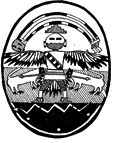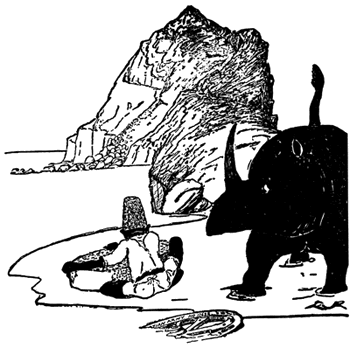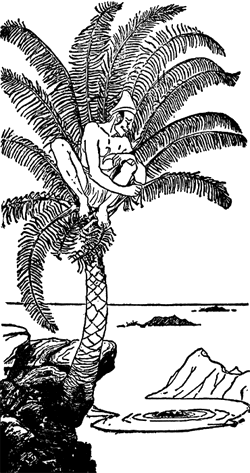|
|

nce upon a time, on an uninhabited island on the shores of the Red Sea, there lived a Parsee from whose hat the rays of the sun were reflected in more-than-oriental splendour. And the Parsee lived by the Red Sea with nothing but his hat and his knife and a cooking-stove of the kind that you must particularly never touch. And one day he took flour and water and currants and plums and sugar and things, and made himself one cake which was two feet across and three feet thick. It was indeed a Superior Comestible (that’s Magic), and he put it on stove because he was allowed to cook on the stove, and he baked it and he baked it till it was all done brown and smelt most sentimental. But just as he was going to eat it there came down to the beach from the Altogether Uninhabited Interior one Rhinoceros with a horn on his nose, two piggy eyes, and few manners. In those days the Rhinoceros’s skin fitted him quite tight. There were no wrinkles in it anywhere. He looked exactly like a Noah’s Ark Rhinoceros, but of course much bigger. All the same, he had no manners then, and he has no manners now, and he never will have any manners. He said, ‘How!’ and the Parsee left that cake and climbed to the top of a palm tree with nothing on but his hat, from which the rays of the sun were always reflected in more-than-oriental splendour. And the Rhinoceros upset the oil-stove with his nose, and the cake rolled on the sand, and he spiked that cake on the horn of his nose, and he ate it, and he went away, waving his tail, to the desolate and Exclusively Uninhabited Interior which abuts on the islands of Mazanderan, Socotra, and Promontories of the Larger Equinox. Then the Parsee came down from his palm-tree and put the stove on its legs and recited the following Sloka, which, as you have not heard, I will now proceed to relate:—
Them that takes cakes
Which the Parsee-man bakes
Makes dreadful mistakes.
And there was a great deal more in that than you would think.
Because, five weeks later, there was a heat wave in the Red Sea, and everybody took off all the clothes they had. The Parsee took off his hat; but the Rhinoceros took off his skin and carried it over his shoulder as he came down to the beach to bathe. In those days it buttoned underneath with three buttons and looked like a waterproof. He said nothing whatever about the Parsee’s cake, because he had eaten it all; and he never had any manners, then, since, or henceforward. He waddled straight into the water and blew bubbles through his nose, leaving his skin on the beach.
Presently the Parsee came by and found the skin, and he smiled one smile that ran all round his face two times. Then he danced three times round the skin and rubbed his hands. Then he went to his camp and filled his hat with cake-crumbs, for the Parsee never ate anything but cake, and never swept out his camp. He took that skin, and he shook that skin, and he scrubbed that skin, and he rubbed that skin just as full of old, dry, stale, tickly cake-crumbs and some burned currants as ever it could possibly hold. Then he climbed to the top of his palm-tree and waited for the Rhinoceros to come out of the water and put it on.
And the Rhinoceros did. He buttoned it up with the three buttons, and it tickled like cake crumbs in bed. Then he wanted to scratch, but that made it worse; and then he lay down on the sands and rolled and rolled and rolled, and every time he rolled the cake crumbs tickled him worse and worse and worse. Then he ran to the palm-tree and rubbed and rubbed and rubbed himself against it. He rubbed so much and so hard that he rubbed his skin into a great fold over his shoulders, and another fold underneath, where the buttons used to be (but he rubbed the buttons off), and he rubbed some more folds over his legs. And it spoiled his temper, but it didn’t make the least difference to the cake-crumbs. They were inside his skin and they tickled. So he went home, very angry indeed and horribly scratchy; and from that day to this every rhinoceros has great folds in his skin and a very bad temper, all on account of the cake-crumbs inside.
But the Parsee came down from his palm-tree, wearing his hat, from which the rays of the sun were reflected in more-than-oriental splendour, packed up his cooking-stove, and went away in the direction of Orotavo, Amygdala, the Upland Meadows of Anantarivo, and the Marshes of Sonaput.
This Uninhabited Island
Is off Cape Gardafui,
By the Beaches of Socotra
And the Pink Arabian Sea:
But it’s hot—too hot from Suez
For the likes of you and me
Ever to go
In a P. and 0.
And call on the Cake-Parsee!
|
|

trora vivía, en una isla deshabitada de las costas del mar Rojo, un parsi en cuyo sombrero los rayos del sol se reflejaban con esplendor más que oriental. Y el parsi vivía junto al mar Rojo únicamente con el sombrero, un cuchillo y una cocina de ésas que, sobre todo, nunca tienes que tocar. Y un día juntó harina, agua, pasas, ciruelas, azúcar y más cosas y se hizo un pastel que tenía medio metro de ancho y un metro de grueso. Era, en verdad, un comestible superior (eso es magia), y lo metió en el horno, porque él sí tenía permiso para cocinar y lo coció y lo coció hasta que se puso bien dorado y soltó un olor muy nostálgico. Ahora bien, justo cuando se lo iba a comer, a la playa llegó desde el interior completamente deshabitado un rinoceronte con un cuerno en la nariz, dos ojos de cerdito y muy pocos modales. En aquel tiempo la piel del rinoceronte le quedaba bastante ajustada. No tenía arrugas en ningún sitio. Su aspecto era el mismo que el rinoceronte del arca de Noé, claro que mucho más grande. De todas formas, no tenía modales ya entonces, no los tiene ahora y no los tendrá nunca.
—¡Buh! —dijo.
Y el parsi dejó el pastel y se subió a lo alto de una palmera llevando consigo únicamente el sombrero en el que los rayos del sol se reflejaban con un esplendor más que oriental. Y el rinoceronte volcó la cocina de petróleo con la nariz y el pastel rodó por la arena; el rinoceronte lo ensartó con el cuerno de la nariz, se lo comió y se alejó, meneando la cola, hacia el desolado interior exclusivamente deshabitado que linda con las islas de Mazandarán, Socotora y los promontorios del Equinoccio Mayor. Entonces el parsi bajó de su palmera, volvió a poner de pie la cocina y recitó el siguiente sloka, que como no habrás oído, te voy a recitar:
Quien los pasteles se zampa
que el hombre parsi prepara
del todo mete la pata.
Y tras esas palabras había mucho más de lo que imaginas.
Porque, cinco semanas más tarde, hubo una ola de calor en el mar Rojo, y todo el mundo se quitó la ropa llevaba. El parsi se quitó el sombrero; el rinoceronte se quitó la piel y cargó con ella encima del hombro mientras bajaba a la playa para bañarse. En aquel tiempo la piel se abrochaba por debajo con tres botones y parecía un impermeable. El rinoceronte no hizo ningún comentario acerca del pastel del parsi porque se lo había comido todo; nunca había tenido modales, ni entonces, ni ahora ni nunca. Dejó la piel en la orilla, se metió directamente en el agua y se puso a sacar burbujas por la nariz.
En ese momento llegó el parsi, vio la piel y sonrió con una sonrisa que le daba dos veces la vuelta la cara. Luego bailó tres veces alrededor de la piel y se frotó las manos. Luego fue a su campamento y se llenó el sombrero de migas de pastel, porque el parsi sólo comía pastel y nunca barría el campamento. Agarró la piel y la sacudió, la restregó, la frotó y la llenó tanto como fue posible de migajas de pastel viejas, secas, rancias y picosas, y también de algunas pasas requemadas. Luego se subió a lo alto de su palmera y esperó a que el rinoceronte saliera del agua y se la volviera a poner.
Y eso fue lo que hizo el Rinoceronte. Se abrochó los tres botones, y la piel empezó a picarle como pican las migajas de pastel en la cama. Entonces quiso rascarse, pero eso no hizo más que empeorar las cosas; y se echó en la arena y rodó, rodó y rodó; y cada vez que rodaba las migajas de pastel le picaban más, más y más. Luego corrió hasta la palmera y se frotó, frotó y frotó contra ella. Se frotó tanto y tan fuerte que de frotar se le hizo un gran pliegue en la piel de los hombros y otro debajo, donde estaban los botones (pero los botones se los arrancó de frotarse) y de tanto frotar le salieron algunos pliegues más en las patas. Y se le agrió el carácter, pero las migajas de pastel siguieron igual. Estaban por dentro de la piel y picaban. Así que se fue a su casa, enfadadísimo y con un picor espantoso; y desde entonces hasta el día de hoy los rinocerontes tienen grandes pliegues en la piel y muy mal genio, todo por las migajas de pastel que no pueden sacarse de encima.
El parsi, en cambio, bajó de la palmera con su sombrero en el que los rayos del sol se reflejaban con esplendor más que oriental y se alejó en dirección a Orotava, Amígdalas, las altiplanices de Tananarive y las marismas de Sonaput.
La isla desierta tiene
cabo Guardafuí al lado,
las playas de Socotora
y el mar de Omán Rosado;
pero hace calor, tan lejos de Suez,
ni a ti ni a mí será fácil
que a bordo de un barco
un día vayamos
de visita a ver al parsi.
|
|
|
|
 |
|
This is the picture of the Parsee beginning to eat his cake on the Uninhabited Island in the Red Sea on a very hot day; and of the Rhinoceros coming down from the Altogether Uninhabited Interior, which, as you can truthfully see, is all rocky. The Rhinoceros's skin is quite smooth, and the three buttons that button it up are underneath, so you can't see them. The squiggly things on the Parsee's hat are the rays of the sun reflected in more-than-oriental splendour, because if I had drawn real rays they would have filled up all the picture. The cake has currants in it; and the wheel-thing lying on the sand in front belonged to one of Pharaoh's chariots when he tried to cross the Red Sea. The Parsee found it, and kept it to play with. The Parsee's name was Pestonjee Bomonjee, and the Rhinoceros was called Strorks, because he breathed through his mouth instead of his nose. I wouldn't ask anything about the cooking-stove if I were you. |
|
Éste es un dibujo del parsi, que empieza a comerse el pastel en la isla desierta del mar Rojo en un día muy caluroso, y del rinoceronte, que baja del interior completamente deshabitado y que como se puede ver con mucha claridad tiene un terreno rocoso. La piel del rinoceronte es muy tersa, y los tres botones que la abrochan están en la parte de abajo, por lo que no los puedes ver. Los garabatos del sombrero del Parsi son los rayos de sol reflejados con esplendor más que oriental, porque si hubiera pintado los rayos de verdad habrían llenado todo el dibujo. El pastel tiene pasas, y esa rueda que hay en la arena delante de todo perteneció a uno de los carros del faraón cuando intentó cruzar el mar Rojo. El parsi la encontró y se la quedó para jugar con ella. El parse se llamaba Pentonyi Bomonyi, y al Rinoceronte lo llamaban Strorks, porque respiraba por la boca en vez de hacerlo por la nariz. Yo que tú no le preguntaría nada acerca de la cocina. |
|
|
|
 |
|
|
|
This is the Parsee Pestonjee Bomonjee sitting in his palm-tree and watching the Rhinoceros Strorks bathing near the beach of the Altogether Uninhabited Island after Strorks had taken off his skin. The Parsee has put the cake-crumbs into the skin, and he is smiling to think how they will tickle Strorks when Strorks puts it on again. The skin is just under the rocks below the palm-tree in a cool place; that is why you can't see it. The Parsee is wearing a new more-than-oriental-splendour hat of the sort that Parsees wear; and he has a knife in his hand to cut his name on palm-trees. The black things on the islands out at sea are bits of ships that got wrecked going down the Red Sea; but all the passengers were saved and went home. The black thing in the water close to the shore is not a wreck at all. It is Strorks the Rhinoceros bathing without his skin. He was just as black underneath his skin as he was outside. I wouldn't ask anything about the cooking-stove if I were you. |
|
Aquí está el parsi Pentonyi Bomonyi sentado en su palmera y contemplando al rinoceronte Strorks bañándose en la playa de la isla completamente deshabitada tras haberse quitado la piel. El Parsi le ha metido en la piel migas de pastel y sonríe al pensar en lo que le van a picar. La piel está debajo de unas piedras al pie de la palmera, en un lugar fresco; por eso no la puedes ver. El Parsi lleva un sombrero nuevo de esplendor más que oriental como los que llevan los parsis; y sostiene en la mano un cuchillo para grabar su nombre en los troncos de las palmeras. Las cosas negras que se ven junto a las islas en medio del mar son barcos que naufragaron al descender por el mar Rojo, pero todos los pasajeros se salvaron y se fueron a su casa. La cosa negra que hay en el agua cerca de la orilla no es ningún barco naufragado. Es Strorks, el Rinoceronte, bajándodose sin la piel. Por debajo de la piel es tan negro como por encima. Yo que tú no le preguntaría nada acerca de la cocina. |
|
|

